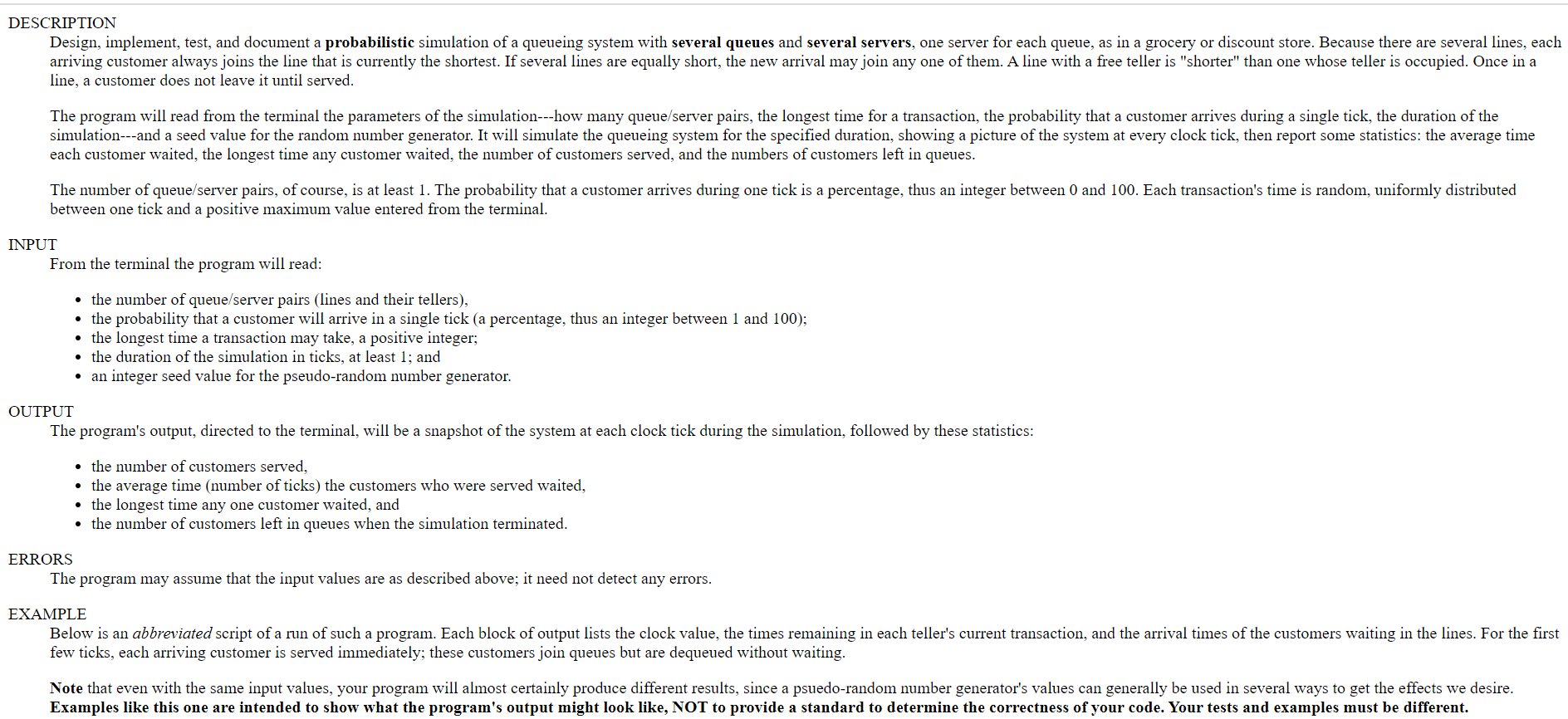IN C++


DESCRIPTION Design, implement, test, and document a probabilistic simulation of a queueing system with several queues and several servers, one server for each queue, as in a grocery or discount store. Because there are several lines, each arriving customer always joins the line that is currently the shortest. If several lines are equally short, the new arrival may join any one of them. A line with a free teller is "shorter" than one whose teller is occupied. Once in a line, a customer does not leave it until served. The program will read from the terminal the parameters of the simulation--- how many queue/server pairs, the longest time for a transaction, the probability that a customer arrives during a single tick, the duration of the simulation---and a seed value for the random number generator. It will simulate the queueing system for the specified duration, showing a picture of the system at every clock tick, then report some statistics: the average time each customer waited, the longest time any customer waited, the number of customers served, and the numbers of customers left in queues. The number of queue/server pairs, of course, is at least 1. The probability that a customer arrives during one tick is a percentage, thus an integer between 0 and 100. Each transaction's time is random, uniformly distributed between one tick and a positive maximum value entered from the terminal. INPUT From the terminal the program will read: the number of queue/server pairs (lines and their tellers), the probability that a customer will arrive in a single tick (a percentage, thus an integer between 1 and 100); the longest time a transaction may take, a positive integer; the duration of the simulation in ticks, at least 1; and an integer seed value for the pseudo-random number generator. OUTPUT The program's output, directed to the terminal, will be a snapshot of the system at each clock tick during the simulation, followed by these statistics: the number of customers served, the average time (number of ticks) the customers who were served waited, the longest time any one customer waited, and the number of customers left in queues when the simulation terminated. ERRORS The program may assume that the input values are as described above; it need not detect any errors. EXAMPLE Below is an abbreviated script of a run of such a program. Each block of output lists the clock value, the times remaining in each teller's current transaction, and the arrival times of the customers waiting in the lines. For the first few ticks, each arriving customer is served immediately; these customers join queues but are dequeued without waiting. Note that even with the same input values, your program will almost certainly produce different results, since a psuedo-random number generator's values can generally be used in several ways to get the effects we desire. Examples like this one are intended to show what the program's output might look like, NOT to provide a standard to determine the correctness of your code. Your tests and examples must be different. Enter these parameters of the simulation: The number of queue/server pairs: 4 The probability that a customer arrives in one tick (%): 80 The maximum duration of a transaction in ticks: 12 The duration of the simulation in ticks: 120 Enter a random number seed: 3 1 4 0 2 3 DU CON 118 1 6 3 12 79 82 91 96 100 102 109 114 116 80 87 88 97 101 103 110 115 90 92 94 98 104 107 111 112 93 95 99 105 108 113 118 119 5 2 11 79 82 91 96 100 102 109 114 116 80 87 88 97 101 103 110 115 90 92 94 98 104 107 111 112 93 95 99 105 108 113 118 119 120 3 82 91 96 100 102 109 114 116 4 80 87 88 97 101 103 110 115 1 90 92 94 98 104 107 111 112 10 93 95 99 105 108 113 118 119 68 customers waited an average of 16 ticks. The longest time a customer waited was 41 ticks. 32 customers remain in the lines. OTHER REQUIREMENTS Implement the Queue abstract data type in a class, using the sequential (array-based) implementation described in class. Declare the arrays of queues and of teller times after the program has read in the number of line/teller pairs, so that the program has exactly the specified number of each and there is no upper limit on the number of lines. Initially, the array of teller times is all zeros. When a teller is free---that is, when a value in this array is zero---and its queue is not empty, then a customer is dequeued from that queue and served. HINTS Address this project in two parts. First, build the class that provides the queue implementation. This part of the project does not depend on how the class's facilities will be used. Then construct the main client program that uses the Queue type that the class provides. In the main program, consider a function that returns the index of the "shortest" line. This function should examine both the lengths of the queues and the remaining transaction times. Consider also a function that returns the total length of all the queues. WHAT TO HAND IN See About Programming Assignments for a description of what to hand in: design document, code, user document, tests, and summary. Use runs of your program to answer this question: If the probability that a customer arrives during one tick is 0.40, and the maximum transaction time is six ticks, what is the smallest number of lines and tellers the system can have and usually keep the average time customers wait below five ticks? Consider simulations at least 100 ticks long, and explain how you arrived at your conclusion









